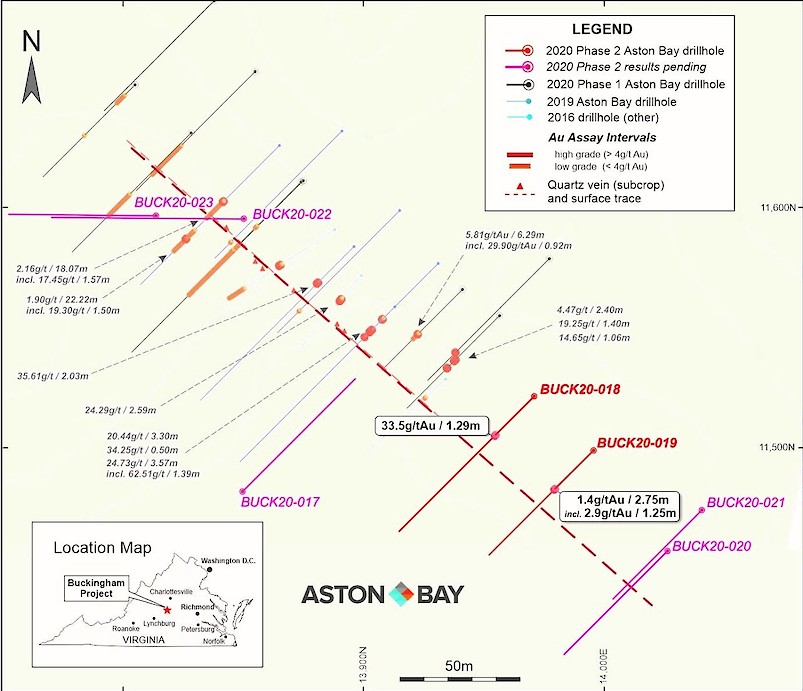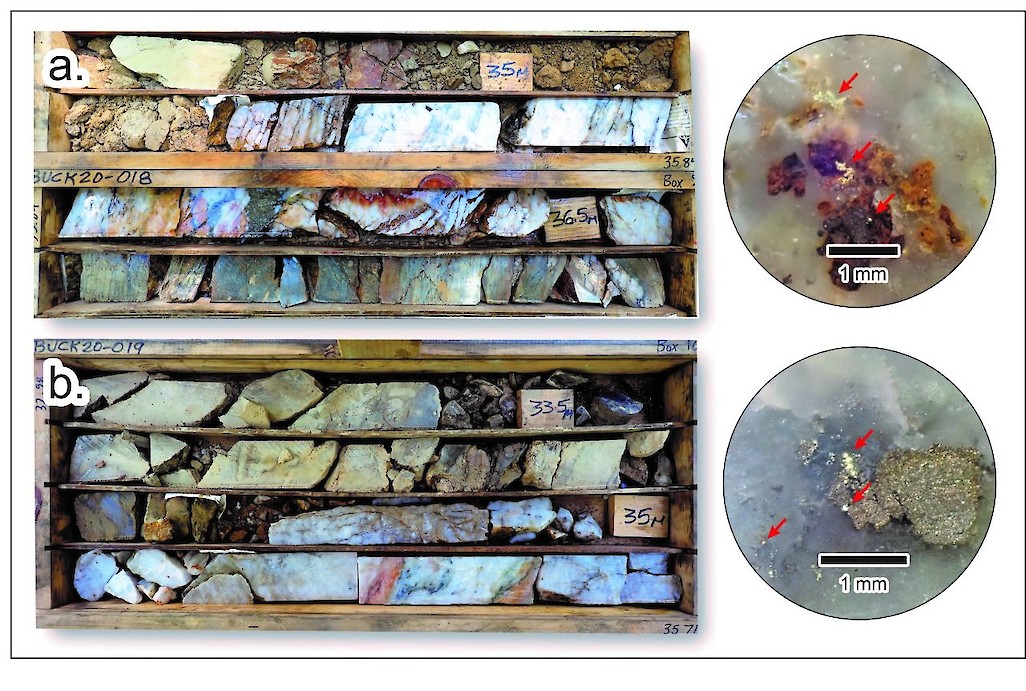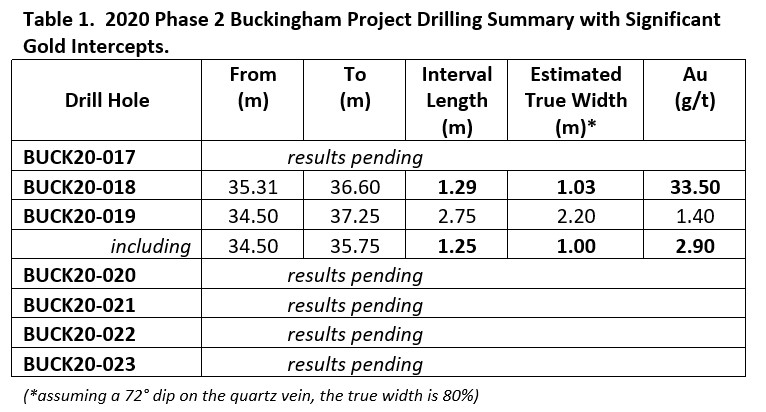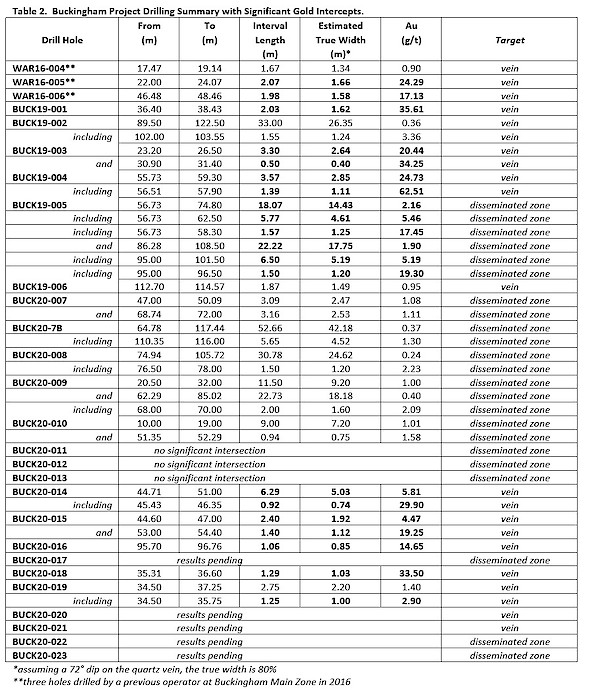News
Aston Bay Holdings Intercepts 33.50 g/t Au over 1.29 m in Initial Phase 2 Results at its Buckingham Gold Project, Virginia, USA
Highlights
- 33.50 g/t Au over 1.29 m (BUCK-018) in a 33 m step-out from previous drilling
- 1.40 g/t Au over 2.75 m including 2.90 g/t Au over 1.25 m (BUCK-019) in 66 m step-out from previous drilling
- Assays pending from drill holes BUCK-020 and -021, which intersected quartz veining with visible gold a farther 52 m to the southeast
- Total known vein strike length of over 200 m; vein remains open to southeast and at depth
Aston Bay Holdings Ltd. (TSX-V:BAY; OTCQB:ATBHF) (“Aston Bay” or the “Company”) is pleased to present initial assay results from two drill holes from the recently completed Phase 2 diamond drill program at its Buckingham Gold Property located in Central Virginia, USA. Phase 2 of the 2020 Buckingham drill program comprised seven (7) large diameter (HQ) oriented diamond drill holes totaling 803 metres (m), which added to the 1,218 m drilled in ten holes in the first phase of the program in March (see August 4, 2020 Aston Bay press release). The significant gold intersections from the first Phase 2 drill holes assayed to date are presented in Table 1. The assay results for the remaining five holes are pending.
Drill hole locations with the significant gold intercepts can be seen in Figure 1 and in a longitudinal cross section in Figure 2. Refer to the July 27, 2019 Aston Bay news release for additional information on previous drilling.
“These intercepts confirm the extension of the gold-bearing Buckingham Vein to the southeast and once again demonstrate high grade gold mineralization in this mesothermal-type vein,” stated Thomas Ullrich, CEO of Aston Bay. “We look forward to the pending results from holes 20 and 21, located 50 m farther along strike, both of which intersected quartz vein with visible gold, as well as assays from the three holes targeting zones of disseminated sericite-pyrite-quartz-gold mineralization below significant gold-in-soil anomalies to the west of the vein.”
“The Buckingham Vein is a mesothermal type vein, with visible gold and sulfides in quartz and associated with sericite and carbonate alteration. The veins appear to be closely related to zones of faulting and shearing within the altered metavolcanic host. They typically lack the banding textures of epithermal veins and have only very low levels of the classic epithermal pathfinder elements. Mesothermal veins are known to host deposits with significant extent and impressive gold grades elsewhere in the world such as the greenstone/Archean deposits in Quebec and Ontario and lode veins of the western US, so the identification of these mesothermal gold-bearing systems at Buckingham is very encouraging. Their presence in this area may have been overlooked due to the deep weathering profile and scarcity of rock outcropping at the surface. We are excited to discover these types of veins at Buckingham and plan to broaden our exploration program for additional occurrences in Virginia.”
About the Buckingham Main Zone
Discovered by prospecting in 2015 following up on a gold anomaly from a 1996/97 stream sediment survey, the NW-SE trending Buckingham Main Zone comprises a series of visible gold-bearing quartz vein outcrops that extend over a strike length of some 150 m at surface and have yielded grab sample assay values up to 701 grams per tonne (g/t) Au. Three core holes drilled on the vein in 2016 yielded significant core-length intercepts of 17.1 g/t Au over 1.98m (WAR16-06) and 24.3 g/t Au over 2.59m (WAR16-05).
2019 Drilling
The veining and alteration encountered in the 2019 drill program included core-length intercepts of up to 35.6 g/t Au over 2.03 m and 24.7 g/t Au over 3.57 m in gold-bearing quartz veins, as well as 2.2 g/t Au over 18.1 m and 1.9 g/t Au over 22.2 m in adjacent but separate sericite-quartz-pyrite alteration zones (see June 5, 2019 Aston Bay release).
Phase 1 2020 Drilling
The Phase 1 2020 drill program encountered veining and alteration similar to that in the 2019 drilling of the zone, yielding core length intercepts of 5.81 g/t Au over 6.29 m including 29.9 g/t Au over 0.92 m, 19.25 g/t Au over 1.4 m and 14.54 g/t Au over 1.06 m in quartz vein material (refer to July 22, 2020 Aston Bay news release).
Phase 2 2020 Drilling
In this recently completed Phase 2 drilling, four of the drill holes (BUCK-018 through BUCK-021, see Figure 1) targeted the along-strike projection of the Buckingham Vein; all four holes intersected visible gold-bearing quartz vein material indicating an along-strike extension of 150 m from the 2019 drilling for a total known strike length of over 200 m for the vein. Results from two of the drill holes are presented here (33.50 g/t Au over 1.29 m in BUCK-018 and 1.40 g/t Au over 2.75 m including 2.90 g/t Au over 1.25 m in BUCK-019); results from the two remaining drill holes with visible gold-bearing quartz vein intercepts (BUCK-020 and -021) are pending. Three drill holes (BUCK-017, -022 and -023; results also pending) targeted gold-in-soil anomalies to the west and southwest of the vein and intersected broad zones of sericite-quartz-pyrite mineralization similar in character to gold-bearing mineralization intersected in previous drilling.
A table with significant intersections from all drill holes at the Buckingham Vein and surrounding zones of disseminated mineralization in the larger Buckingham Main Zone is presented in Table 2.
Gold in Virginia
The gold-bearing system at the Buckingham Project is hosted within a package of likely late Precambrian or early Cambrian-age sediments, including greywackes with minor quartz-arenites (phyllite, schist and quartzites), within the Appalachian orogenic belt, hosting past producing mines, current gold mines and advanced gold exploration plays in a belt from Georgia, the Carolinas, Virginia, Nova Scotia and through to Newfoundland. This region is the site of the historically prolific Virginia Gold-Pyrite Belt which hosted a reported 250 gold mines that were in production prior to the California gold rush of 1849 but has seen little recent mineral exploration. Gold production has also occurred to the south in the Carolina Slate Belt, notably at OceanaGold’s Haile Mine located in South Carolina with commercial production commencing in 2017 and slated to produce up to 150,000 ounces of gold per year.
Virginia Gold-Pyrite Belt Brownfield Exploration
In addition to the 4,953 acres surrounding the Buckingham vein, Aston Bay has exploration agreements in place for 4,399 acres of private land surrounding several historical gold mine workings and other prospective areas in Virginia. A prospecting program, including surface rock and soil sampling, has been completed on parcels of land located over and adjacent to a historic past-producing mine located 20 km southeast of Buckingham, with results expected in the coming weeks. Continued exploration in these and other brownfields areas is planned throughout the summer and fall.
Samples from the Company’s 2020 Buckingham drill program were shipped to the ALS Laboratory in Vancouver, BC for analysis. A secure chain of custody was maintained, and the program included a comprehensive QAQC program, which did not identify any preparation or analytical issues. Results from the remaining five drill holes (BUCK-017, -020, -021, -022 and -023) are pending. Analysis will be by standard fire assay techniques which will include metallic screen assaying of selected intervals with visible alteration and mineralization (including visible gold). Results are anticipated in the coming weeks.

Figure 1: Plan map with drill hole locations and intial results (BUCK-018 and -019) for 2020 Phase 2 drilling, Buckingham Gold Project, Virginia. Select significant assay intervals from previous drill programs noted. Results for BUCK20-017, -020, -021, -022 and -023 pending. Local grid in metres.
Figure 2: Longitudinal cross section with significant gold intercepts, Buckingham Gold Project, Virginia. 2020. Initial Phase 2 drill intercepts in white boxes; previous drill intercepts in blue italics. Results for BUCK20-017, -020, -021, -022 and -023 pending. View looking northeast.
 Figure 3: Photograph of quartz vein intervals intersected in HQ-sized diamond drill hole a) BUCK-018 and b) BUCK-19 with examples of visible gold depicted at right, indicated by red arrows. Scale as noted.
Figure 3: Photograph of quartz vein intervals intersected in HQ-sized diamond drill hole a) BUCK-018 and b) BUCK-19 with examples of visible gold depicted at right, indicated by red arrows. Scale as noted.
QUALIFIED PERSON
As per National Instrument 43-101 Standards of Disclosure for Mineral Projects, Andrew Turner, P.Geol., a consultant to Aston Bay, is the Qualified Person for the Company and has prepared, validated and approved the technical and scientific content of this news release. The Company strictly adheres to CIM Best Practices Guidelines in conducting, documenting, and reporting its exploration activities.
About Aston Bay Holdings
Aston Bay is a publicly traded mineral exploration company exploring for gold and base metal deposits in Virginia, USA, and Nunavut, Canada. The Company is led by CEO Thomas Ullrich with exploration in Virginia directed by the Company’s advisor, Don Taylor, the 2018 Thayer Lindsley Award winner for his discovery of the Taylor Pb-Zn-Ag Deposit in Arizona.
The Company has acquired the exclusive rights to an integrated dataset over certain prospective private lands and has signed agreements with timber and land companies which grants the company the option to lease the mineral rights to 11,065 acres of land located in central Virginia. These lands are located within a gold-copper-lead-zinc mineralized belt prospective for Carolina slate belt gold deposits and Virginia gold-pyrite belt deposits, as well as sedimentary VMS, exhalative (SEDEX) and Broken Hill (BHT) type base metal deposits. Don Taylor, who led the predecessor company to Blue Ridge and assembled the dataset, has joined the Company’s Advisory Board and will be directing the Company’s exploration activities for the Blue Ridge Project. The Company is actively exploring the Buckingham Gold Project in Virginia and is in advanced stages of negotiation on other lands in the area.
The Company is also 100% owner of the Aston Bay Property located on western Somerset Island, Nunavut, which neighbours Teck’s profitable, past-producing Polaris (Pb-Zn) Mine just 200km to the north. The Aston Bay Property hosts the Storm Copper Project and the Seal Zinc Deposit with drill-confirmed presence of sediment-hosted copper and zinc mineralization.
The Company’s public disclosure documents are available on www.sedar.com.
FORWARD-LOOKING STATEMENTS
Statements made in this press release, including those regarding the closing and the use of proceeds of the private placement, management objectives, forecasts, estimates, expectations, or predictions of the future may constitute “forward-looking statement”, which can be identified by the use of conditional or future tenses or by the use of such verbs as “believe”, “expect”, “may”, “will”, “should”, “estimate”, “anticipate”, “project”, “plan”, and words of similar import, including variations thereof and negative forms. This press release contains forward-looking statements that reflect, as of the date of this press release, Aston Bay’s expectations, estimates and projections about its operations, the mining industry and the economic environment in which it operates. Statements in this press release that are not supported by historical fact are forward-looking statements, meaning they involve risk, uncertainty and other factors that could cause actual results to differ materially from those expressed or implied by such forward-looking statements. Although Aston Bay believes that the assumptions inherent in the forward-looking statements are reasonable, undue reliance should not be placed on these statements, which apply only at the time of writing of this press release. Aston Bay disclaims any intention or obligation to update or revise any forward-looking statement, whether as a result of new information, future events or otherwise, except to the extent required by securities legislation. We seek safe harbour.
Neither TSX Venture Exchange nor its regulation services provider (as that term is defined in policies of the TSX Venture Exchange) accepts responsibility for the adequacy or accuracy of this news release.
FOR ADDITIONAL INFORMATION CONTACT:
Thomas Ullrich, Chief Executive Officer
thomas.ullrich@astonbayholdings.com
(416) 456-3516
Sofia Harquail, IR and Corporate Development
sofia.harquail@astonbayholdings.com
(647) 821-1337


